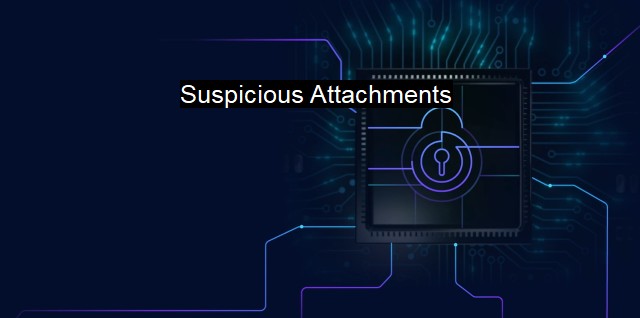What are Suspicious Attachments?
The Peril of Suspicious Attachments: Risks and Best Practices to Protect Against Cyber Threats
"Suspicious attachments" refer to digital files that are suspicious due to their potential to harm a computer system by acting as agents for malware, viruses, or other security threats. Although attachments are an integral feature of digital communication today, they carry significant cybersecurity risks, and the security of millions of computers worldwide can be compromised by suspicious attachments.Identifying, averting, and eliminating such suspicious attachments have undeniably become a priority. Emails, forums and even social media sites provide options for users to send or post attachments, such as documents, images, or executable files. Unfortunately, cyber-attackers can exploit these files to hide malicious software. Once a user opens or downloads such a suspicious attachment, it could wreak havoc on their computer system.
Malware, short for malicious software, covers a range of damaging software types that are designed to harm, respectfully take control away from the user, or exploit a computer system. These could involve activities like extracting personal information, hijacking computer functions, and damaging the computer system's interior. Common examples of malware are viruses, which self-replicate and insert malicious codes into clean files, and Trojan horses, which appear harmless but exploit system vulnerabilities to perform nefarious tasks.
Suspicious attachments can come in varied formats, known popularly which entail of documents, PDFs, and ZIP files. The attachments may appear unsuspecting and vital, such as a work document or an invoice. The perpetrators often do this in these seemingly innocuous forms to manipulate the recipient into opening them.
So how can these suspicious attachments get past antivirus software? First, not all antivirus softwares are foolproof—some can omit threats due to outdated virus definitions or sophisticated evasive techniques employed by the malware. Sometimes, the malware might be encoded or compressed to abstain detection. novel malware that hasn't been identified, also known as zero-day threats, can evade detection.
Mitigating risks from suspicious attachments and ensuring cybersecurity involves a multi-pronged approach. This process starts with the use of a dependable, up-to-date antivirus software and firewall systems that can automatically scan and detect harmful attachments even before they are clicked. These protections are accompanied by regularly updating one's operating system and software because with every different version or patch, vulnerabilities get plugged.
Internet users should employ safe browsing practices, including not downloading attachments from unknown or untrusted sources and being skeptical of attachments from known sources in unsolicited emails. An unusual file type, grammar mistakes in the email message, and odd sender's email address are all warning signs of suspicious attachments.
One crucial strategy is imparting cyber-hygiene education to teach people to discern valid attachments from malicious ones, which involves teaching ways to identify and respond to phishing attempts. Strengthening knowledge on good password practices is also crucial. Besides these, advanced threat-protection solutions designed to dismantle the most resistant attachments can assist in neutralizing risk.
Even with robust cybersecurity measures in place, the inevitable fact remains that nothing stands absolutely invincible against cyber threats; there will always remain an element of risk in today's dynamically evolving cyber climate. both individuals and organizations must prioritize cybersecurity and strive to keep one step ahead against suspicious attachments. It concludes with the premise straightforward that maintaining a state of constant vigilance and awareness against cyber threats forms the crux of safe navigation in the global digital sphere.

Suspicious Attachments FAQs
What should I do if I receive an email with a suspicious attachment?
You should not open the attachment as it may contain malware or viruses that can harm your computer. You should delete the email and report it to your IT department or your antivirus provider.How can I identify a suspicious attachment in an email?
You should look for attachments with unusual file extensions, like .exe, .vbs, or .bat. You should also be wary of attachments that are compressed or encrypted, or have generic names like "document" or "invoice".What is the risk of opening a suspicious attachment?
The risk of opening a suspicious attachment is that it may contain malware, viruses, or other types of malicious code that can harm your computer, steal your personal information, or disrupt your network. By opening the attachment, you expose yourself to these risks, which can be both financial and reputational.How can I protect my computer from suspicious attachments?
You can protect your computer from suspicious attachments by using antivirus software that scans emails and attachments for malware, viruses, and other types of malicious code. You should also keep your software and operating system up-to-date, avoid opening emails from unknown senders, and be cautious with any attachments that you receive, even if they appear to be from a trusted source.| | A | | | B | | | C | | | D | | | E | | | F | | | G | | | H | | | I | | | J | | | K | | | L | | | M | |
| | N | | | O | | | P | | | Q | | | R | | | S | | | T | | | U | | | V | | | W | | | X | | | Y | | | Z | |
| | 1 | | | 2 | | | 3 | | | 4 | | | 7 | | | 8 | | |||||||